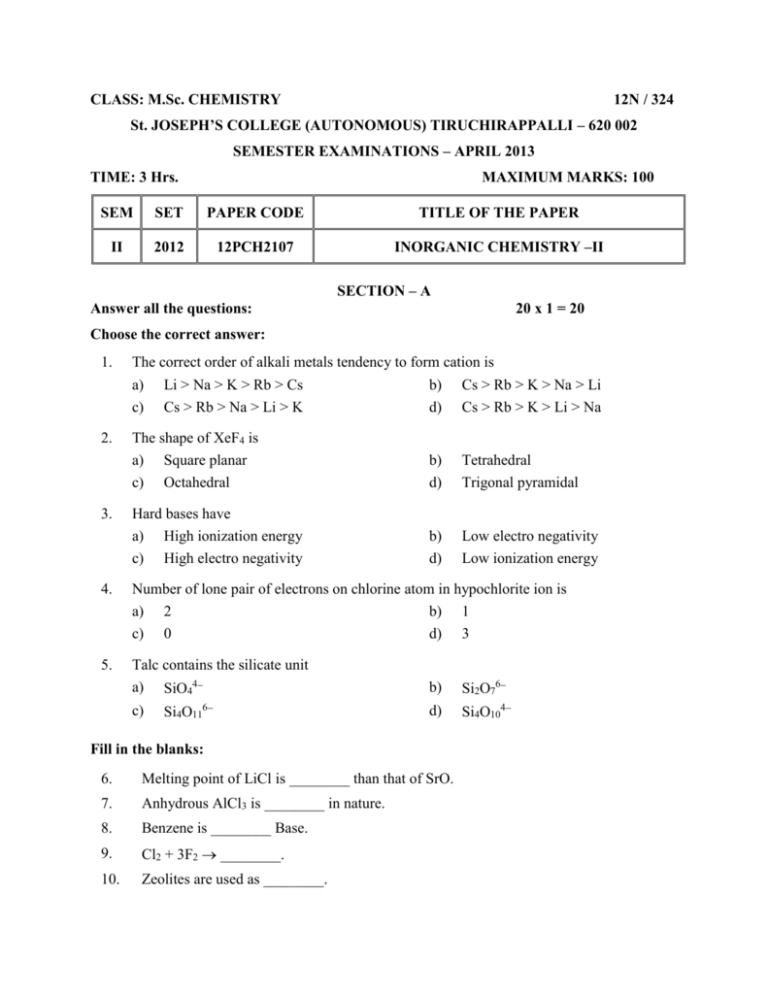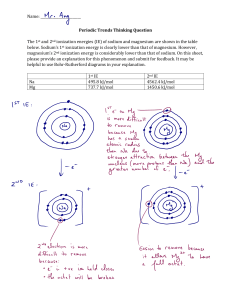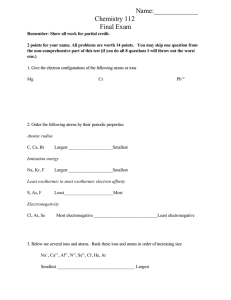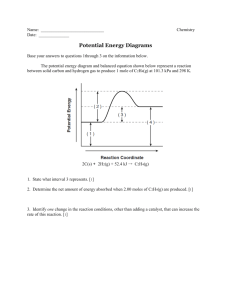INORGANIC CHEMISTRY –II 1
advertisement

CLASS: M.Sc. CHEMISTRY 12N / 324 St. JOSEPH’S COLLEGE (AUTONOMOUS) TIRUCHIRAPPALLI – 620 002 SEMESTER EXAMINATIONS – APRIL 2013 TIME: 3 Hrs. MAXIMUM MARKS: 100 SEM SET PAPER CODE TITLE OF THE PAPER II 2012 12PCH2107 INORGANIC CHEMISTRY –II SECTION – A Answer all the questions: 20 x 1 = 20 Choose the correct answer: 1. The correct order of alkali metals tendency to form cation is a) Li > Na > K > Rb > Cs b) Cs > Rb > K > Na > Li c) Cs > Rb > Na > Li > K d) Cs > Rb > K > Li > Na 2. The shape of XeF4 is a) Square planar c) Octahedral b) d) Tetrahedral Trigonal pyramidal Hard bases have a) High ionization energy c) High electro negativity b) d) Low electro negativity Low ionization energy 3. 4. Number of lone pair of electrons on chlorine atom in hypochlorite ion is a) 2 b) 1 c) 0 d) 3 5. Talc contains the silicate unit a) SiO44 c) Si4O116 b) Si2O76 d) Si4O104 Fill in the blanks: 6. Melting point of LiCl is ________ than that of SrO. 7. Anhydrous AlCl3 is ________ in nature. 8. Benzene is ________ Base. 9. Cl2 + 3F2 ________. 10. Zeolites are used as ________. Answer in one or two sentences: 11. Silver halides are less soluble in water why? 12. State Slater’s rule. 13. Why bond energy of Li2 is smaller than H2? 14. Write the resonance structures of SCN. 15. Why HCl and HClO4 will have equal acid strength is water? 16. Out of water and acetic acid which one will help to determine the relative basic strength of RNH2, R2NH and R3N? 17. How will you prepare periodic acid? 18. Draw the structure of XeF2. 19. Give one property of sulphur nitride. 20. State Wade’s rule. SECTION – B Answer all the questions: 21. a. 5 x 6 = 30 State and explain Fajan’s rule. OR 22. b. Calculate the heat of formation (HF) of KF from its elements from the following data by the case of Born – Haber cycle. Sublimation energy of potassium = 87.8 KJ / mol Dissociation energy of F2 = 158. 9 KG / mol Ionization energy of K = 414.2 KG / mol Electron affinity of F = 334. 7 KG / mol Lattice energy of KF = 807.5 KJ / mol a. Write the resonating structures for CO and explain the causes of its low dipole moment. OR 23. b. On the basis of MO theory explain the magnetic character of N2 and NO molecules. a. Discuss about Usanovich concept of acid and base. OR b. Explain the limitations of Lewis concept of acid and base. 24. a. Describe the preparation and properties of BrF5. OR 25. b. I2 is usually insoluble in water. It dissolves readily in a solution of KI. Discuss the structure of product in this solution. a. Write a short note on closo borane. OR b. Compare Borazine with Benzene. SECTION – C Answer any FIVE questions: 5 x 10 = 50 26. Derive Born – Lande equation. 27. a. Draw MO energy level diagram for HCl molecule. b. The bond energy of NO is 623 KJ / mole where as that of NO+ molecule ion is 1069 KJ / mol justify. 28. a. Arrange the following phosphoric acids in the decreasing order strength H3PO4, H4P2O7, H5P3O10 – Explain. b. Which of the following base in the Weakest why? Cl, I, Br, F. 29. What are Polyhalides? Discuss the structure of ICl2 and ICl4. 30. Explain the structure of various types of silicates. 31. Describe the chemical reaction in liquid HF. ************** of relative acid











